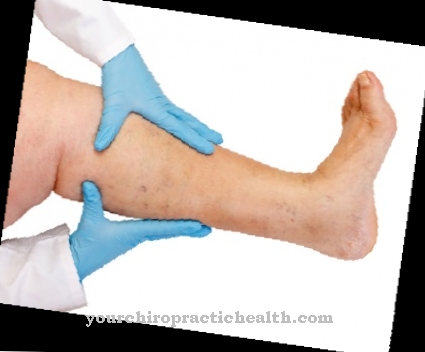The Full moon face usually develops as part of a body fat redistribution due to hormonal causes. It is a typical leading symptom in medicine. As a rule, it occurs together with other characteristic symptoms.
What is a full moon face?

When a full moon face appears, a pathological redistribution of fat in the body must usually be assumed. However, it is not an independent disease, but is a characteristic main symptom in various hormone-related disorders in the organism. It is expressed by a rounded face shape with reddened cheeks. It is also characterized by an oblique position of the eyes, a so-called carp mouth and a double chin.
It occurs mainly in the context of Cushing's syndrome, which is based on an increased cortisol level in the blood. But even with extreme forms of obesity and Pickwick syndrome, a full moon face can develop. It often develops as a side effect as part of the drug treatment of rheumatic diseases, allergies or autoimmune diseases. The formation of a full moon face should always be used as an opportunity to consult a doctor to clarify the cause.
causes
The full moon face typically occurs in what is known as Cushing's syndrome. This syndrome is caused by increased levels of the stress hormone cortisol in the blood. This leads to a redistribution of body fat with the development of trunk obesity with a bull's neck and full moon face. Cortisol has the task of quickly supplying the organism with energy in stressful situations. It mobilizes the available body reserves in the liver (glucogen) and muscles (protein breakdown).
It triggers the conversion of glucogen and amino acids into glucose. This increases the blood sugar level. As a result, the production of insulin is stimulated, which transports the glucose into the cells for energy production. Unfortunately, in Cushing's syndrome it is not an increased need for glucose that is responsible for the increase in the cortisol value, but the pathological overproduction or the additional administration of cortisol as part of a drug treatment. The body's energy needs have not increased.
This stores the released glucose as fat. Cortisol thus breaks down muscle mass and converts it into fat. At the same time, the bone density also decreases. Since cortisol also has an immunosuppressive effect, the immune system is also weakened. In the medical treatment of allergies, rheumatism and other autoimmune diseases with cortisone-containing drugs, however, this is exactly what should be achieved in order to weaken the excessive reaction of the immune system against parts of the own body. Other causes of a full moon face can also be extreme forms of obesity such as Fröhlich's syndrome.
You can find your medication here
➔ Medicines for weight loss & dietDiseases with this symptom
- Cushing Syndrome
- Autoimmune disease
- Obesity
- rheumatism
- Merry Syndrome
- Pickwick Syndrome
Symptoms, ailments & signs
As already mentioned, increased cortisol concentrations in the blood cause the so-called Cushing's syndrome with a full moon face as a typical leading symptom. Regardless of the cause of the increased hormone levels, the same characteristic clinical picture appears. The patient therefore suffers from trunk obesity with a bull's neck and a full moon face. Furthermore, infections often occur due to the weakened immune system.
Bones and muscles are broken down. This can lead to osteoporosis and muscle wasting. The connective tissue is also affected. So-called Striae rubrae, Stretch marks, off. These are red strips of skin that arise when the connective tissue is torn. High blood pressure is also a typical symptom of Cushing's syndrome. Furthermore, virilism (masculinization) can occur in women and erectile dysfunction in men.
Depending on the cause of the increased cortisol levels, a distinction is made between exogenous and endogenous Cushing's syndrome. The more frequently occurring exogenous Cushing's syndrome is the result of therapies with cortisol-containing drugs for allergies, rheumatic diseases and autoimmune disorders. Endogenous Cushing's syndrome, which is less common, is caused by an overactive adrenal or pituitary gland. The adrenal glands produce cortisol directly, while the pituitary gland stimulates cortisol synthesis in the adrenal glands through its hormone ACTH. Both benign and malignant tumors can cause the overproduction of hormones.
Diagnosis & course
To diagnose the exact causes of the full moon face, the doctor first uses urine samples to examine whether there are elevated cortisol concentrations. If this is the case, in the case of endogenous Cushing's syndrome, a dexamethasone inhibition test and a CRH test must be carried out to determine at which point the control loop is disturbed. Imaging procedures such as CT, ultrasound or MRI can detect possible tumors on the adrenal glands or pituitary gland.
Complications
A full moon face is a sign of Cushing's syndrome, which has many different complications. On the one hand, the increased cortisol level leads to increased fragility of the bones (osteoporosis). This severely restricts the quality of life, those affected have to be careful and usually need care over time.
This can lead to severe psychological problems especially depression. Depression can be characterized by highly addictive behavior. There are also sleeping and eating disorders. It is not uncommon for people who are chronically depressed to have suicidal thoughts. Furthermore, the affected person's immune system is suppressed, which is more prone to infections.
In the worst case, these can spread and lead to sepsis, which can then end in septic shock. This condition is life-threatening and, if left untreated, leads to death in over half of those affected. The increased reabsorption of water also usually results in high blood pressure (hypertension) in the affected person. This increases the risk of cardiovascular disease and the development of atherosclerosis.
Cushing patients also usually develop diabetes. This clogs smaller vessels and leads to insufficient blood flow, especially to the kidneys and eyes, which can eventually lead to kidney weakness or poor eyesight to kidney failure or blindness.
When should you go to the doctor?
A moon face can be family-related. It does not necessarily have to have a disease value. It is also known, however, that people develop a full moon face after prolonged treatment with cortisone. This can be reduced in the medium term through a change in diet. The increased appetite caused by the cortisone can be effectively undermined by nutritional advice.
A full moon face can also occur in Cushing's syndrome. An overproduction of adrenal cortex hormones can be determined as the cause by the doctor consulted. If this disease or hypercortisolism is suspected, it must be determined whether it is a possible consequence of long-term cortisone administration or the effects of a (benign) tumor. This may have formed in the adrenal cortex, the pituitary gland or the bronchi.
In addition to the full moon face, the attending physician usually notices an increase in weight on the upper body. He can also use other typical features to conclude that Cushing's syndrome is present. Various examinations such as a 24-hour urine check can determine the cause of the full moon face. Thereafter, there is either a referral to a hospital for the purpose of surgery or radiation of a tumor, or drug treatment is also conceivable.
Alternatively, attempts are made to lower the cortisol concentration in the blood. If a full moon face appears repeatedly, permanent medical supervision is necessary.
Doctors & therapists in your area
Treatment & Therapy
The treatment of the full moon face depends on the cause. If there is an increased cortisol concentration due to the intake of cortisol-containing medication, its application must be gradually reduced if Cushing's syndrome is severe. However, the medication must not be stopped abruptly because the hormone control loop would not react immediately. They must be withdrawn gradually.
If the high cortisol level has endogenous causes, surgical intervention on the adrenal glands or the pituitary gland may be necessary if a tumor is present. If this is not possible, radiation or chemotherapy is an option. Drug treatments to inhibit cortisol formation can also be used in certain forms of Cushing's syndrome. After the normalization of the cortisol level, the symptoms of Cushing's syndrome including the full moon face disappear very quickly.
Outlook & forecast
In itself, a full moon face is harmless. This is especially true if it exists for hereditary reasons or is due to excessive weight. A full moon face does not have to have any disease value. If you are very overweight, it is to be regarded as a consequence of increasing obesity. Here, clinically supported diets or a stomach reduction over a longer period of time can ensure that the obese patient works out a better prognosis.
However, if the full moon face is Cushing's syndrome, the outlook is worse. This is a hormonal full moon face. This is related to increased cortisol production. In this rare condition, the full moon face can be a symptom of adrenal disorders or problems with the pituitary gland. Often it is the result of a benign tumor of the pituitary gland, a so-called adenoma. The prognosis for the full moon face is quite good if the underlying disease or disorder is treated properly.
A full moon face can also occur if drugs containing cortisone are administered over a long period of time. This may be necessary, for example, in the case of chronic inflammatory bowel disease or bronchial asthma. As a side effect, Cushing's syndrome with a full moon face can occur. This disappears again as soon as the medication is stopped. Overall, the prognosis is good with appropriate treatment.
You can find your medication here
➔ Medicines for weight loss & dietprevention
Prevention is only possible against the full moon face in the context of extreme obesity. Hormone-independent obesity can be prevented through a healthy diet and sufficient physical activity. However, Cushing's syndrome cannot be avoided even through prevention.
When administering medication containing cortisol, however, the patient should be monitored continuously. If symptoms such as trunk obesity with a full moon face and bull's neck as well as frequent infections occur during the use of the medicament, an adjustment of the medicamentous treatment is urgently required.
You can do that yourself
A so-called full moon face can occur in the context of various diseases. Characteristics are a round, reddened face, often puffy, bluish cheeks, slanting eyes and a double chin. The mouth is also deformed; women often experience hirsutism in this context.
In addition to medical treatment, those affected can do a number of things themselves to alleviate their suffering. On the one hand, cosmetic treatments such as make-up are conceivable, whereby patients should seek advice from professional beauticians on their specific problems. The right haircut can also mitigate optical disruptive factors, as it can make the face appear narrower or even conceal it in places. Excessive hair growth in women can also be treated cosmetically, e.g. by laser therapy, epilation, waxing or plucking).
Even if the facial and body deformations that occur as part of the diseases that bring a full moon face with them are medically justified, regular, targeted exercise can alleviate the worst manifestations. This is especially true if obesity is the cause. The same is the case if a certain drug intake is the cause. In the latter case it should also be considered whether the preparations should not be changed. Exercise can also help to reduce the production of the stress hormone cortisol, which also has a positive effect on fat distribution in the body.




.jpg)



















.jpg)



